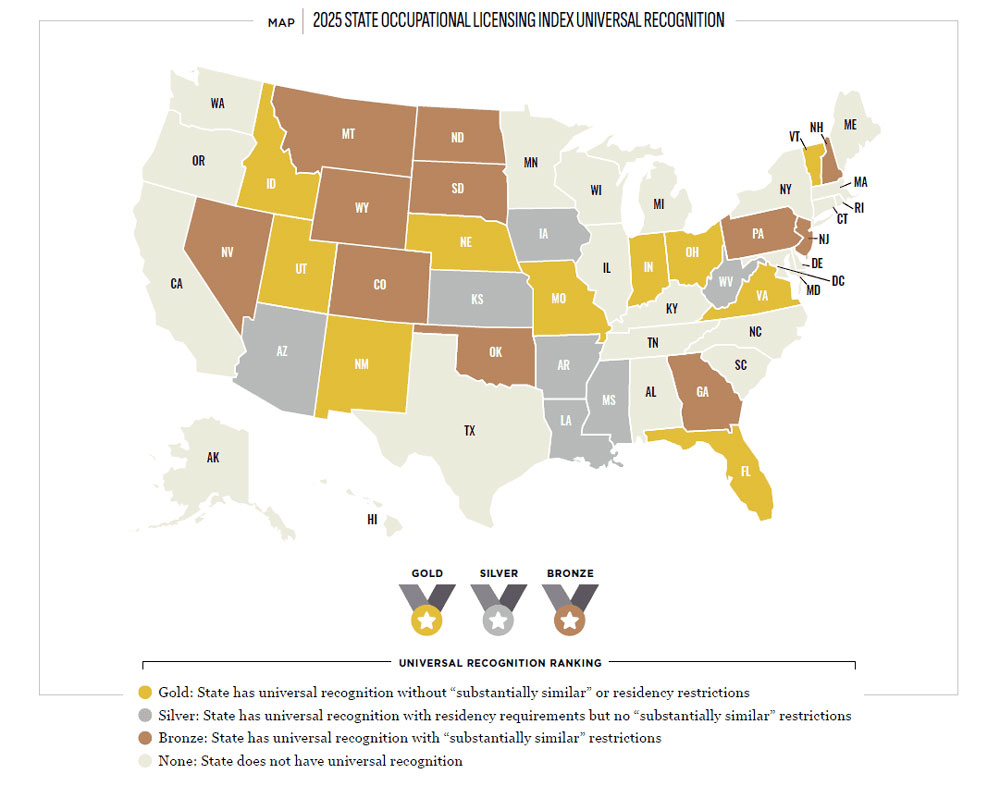Discover How Your State Ranks
Discover how your state ranks in the latest release of the State Occupational Licensing Index. The third edition presents occupational licensing by state, with an updated ranking of all 50 U.S. states and the District of Columbia. We interview Edward Timmons, co- author of the 2025 State Occupational Licensing Index. He breaks down the key takeaways from the occupational license report and explains how to use the information at your regulatory agency.
The 2025 State Occupational Licensing Index measures licensing burdens across occupations and ranks all 50 U.S. states and D.C. In the report, for example, Oregon ranks first, with the highest occupational licensing burden, while Kansas ranks last, with the lowest licensing burden.
“Occupational licensing affects millions of working Americans,” says Timmons, “not to mention millions of Americans who consider entering licensed professions. With over 20 percent of workers directly affected by these rules, it is imperative that people understand where states and regions rank in terms of barriers to work, in addition to which professions are more burdensome or less. Public awareness is the key to change: By understanding what we get right and wrong about occupational licensing, we can strive for reforms that make it easier for people to work and flourish. SOLI 2025 is exactly the education we need for real, lasting change.”
Edward Timmons, Ph.D., serves as a senior research fellow with the Archbridge Institute.

Map of state rankings; Archbridge Institute
Q&A with Edward Timmons
In our interview with report author, Edward Timmons, he uncovers the basics of the occupational license report for your regulatory agency—from key takeaways to uniquely licensed occupations to how to use the information.
GL Solutions: What are the key takeaways from the report?
Ed Timmons: There continues to be large differences from state to state and region to region on the extent of occupational licensing. Oregon (182) restricts entry into 60 more occupations than Kansas (122). There are also large regional differences. The East and West South Central restrict entry for more than 20 more occupations than the Mid-Atlantic and Mountain regions.
GL Solutions: How can a state regulatory agency best use the information in the report?
Ed Timmons: As researchers we know that occupational licensing has large costs in terms of higher prices for consumers and reductions in employment, but has few measurable benefits. If states are using occupational licensing more than other states nationally as a regulatory tool they should review and reconsider their current approach. There are more effective means of reducing harm to consumers that are far less costly as occupational licensing.
GL Solutions: How did the 2025 report compare to the 2024 report? Any notable changes?
Ed Timmons: We revised the count of occupations, trying to provide the most accurate representation of occupational licensing in each state. On the website, we have also added a new interactive map so that states can easily see how they rank relative to other states nationally.
GL Solutions: Did you notice any occupational licensing trends?
Ed Timmons: Occupational licensing continues to expand nationally. We noted at least 6 new instances of new licenses.
GL Solutions: What are some of the uniquely licensed occupations?
Ed Timmons: There are 3 occupations (HIV-AIDS counselor, lightning protection installer, and mold remediation worker) that are licensed in just one state. Rhode Island uniquely licenses the first two and Texas licenses the third. There are 28 occupations that are licensed in 5 states or less. Puerto Rico uniquely licenses 13 distinct occupations.

Map of universal recognition in the United States; Archbridge Institute
GL Solutions: How has universal recognition evolved from 2024 to 2025 in terms of state participation?
Ed Timmons: We saw 3 states and jurisdictions (North Dakota, Puerto Rico, and West Virginia) enact universal recognition reform this year. The reform is now in place in 29 states and jurisdictions.
GL Solutions: Why should states consider universal recognition?
Ed Timmons: It is a common sense reform. Licensed professionals in good standing are able to more easily continue working when they move to another state, or in many cases, when they work across a state border. Research shows that this increases in-migration, increases employment and labor force participation, and increases tax receipts in reform states. New research also shows that the reform improves patient access to doctors.
GL Solutions: In summary, can you explain how you ranked the states?
Ed Timmons: Using a subset of licensed occupations nationally, we counted up the number of occupations from the list that each state licenses. We also took a careful look at the tasks associated with an occupation and if there were legal restrictions from another license and attempted to quantify this also. One such example is an embalmer. Thirty-four states have a separate license, but every state with the exception of Colorado currently makes it illegal to do the job without a funeral director’s license. Counting up cases like these is where we arrive at the barriers score. We include both a barriers score and licensing score for all 50 states and the District of Columbia.
GL Solutions: What role did you play in creating the index?
Ed Timmons: I assisted in every aspect of the report from quantifying the number of licenses and barriers, assisting with the writing, and also tracking universal recognition reforms nationally. Noah Trudeau, my co-author, devised the methodology and concept and is the lead author. We are also happy to add Ben Seevers this year and he was a vital contributor in producing the report.
GL Solutions: Any other comments on the report?
Ed Timmons: We hope the report is useful and at Archbridge we are happy to serve as a resource for any state interested in reviewing the landscape of occupational licensing.
About GL Solutions
GL Solutions celebrates 25 years of helping state regulatory agencies better serve the public with their licensing and permitting software, GL Suite. GL Suite transforms and digitizes operations for scores of agencies and departments nationwide; state agencies from Alaska to Connecticut use GL Suite to improve processes and outcomes.
Contact us to learn more about GL Solutions and to connect with one of our industry experts.
Time to Modernize
GL Solutions helps your regulatory agency run, grow and adapt through modern software and automation that helps solve your agency’s greatest challenges. To learn more, contact us.
To receive the latest regulatory news delivered to your inbox each week, subscribe to our newsletter.




